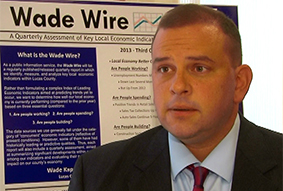Q2 2014 Wade Wire
As my last report suggested, just when the national economy appeared to have gathered and maintained some encouraging momentum to end last year, the Bureau of Economic Analysis (BEA) initially estimated U.S. first quarter 2014 GDP at near-zero growth (0.1%),1 once again disappointing investors and rekindling a debate about the strength of the recovery.
I contended at that time that there appeared to be a substantial disconnect between the April BEA report and the positive data we were surveying among critical national and local economic indicators – especially in the areas of unemployment/hiring and consumer confidence/spending. Agreeing with those economists who pinned the flat first quarter performance primarily on the unusually harsh early-year weather, I remained confident in both the underlying strength of the economy and the likelihood of strong growth in 2014.
Six weeks later, however, the BEA revised downward
its first quarter GDP numbers – concluding that the
U.S. economy had actually shrunk by 2.9% in the first three months of 2014.2 While no one questioned the harsh winter’s detrimental impact, the unexpected size of the drop renewed doubt about the essential health of the economy and even the sustainability of the recovery itself. Regardless, the resulting uncertainty didn’t exactly instill confidence in investors, employers, job-seekers, or consumers. In short, we knew we would likely learn a lot from the BEA’s July 30th GDP Second Quarter 2014 Advance Estimate, and that it couldn’t come soon enough.
With few exceptions, the early data could hardly be more encouraging. Led by a surge in durable goods spending and a big jump in auto sales, second quarter 2014 GDP grew by 4.0%.3 When taken with the news of continued of solid job growth and declining unemployment, the national debate has shifted away from whether the economy is growing toward how and when the Fed will “tap the brakes” to ease its stimulus/bond-buying program and incrementally raise interest rates – in order to keep inflation at bay.
According to our data, it looks like our local economy also picked up the pace in second quarter 2014.
Both Toledo and Lucas County again saw dramatic drops in their unemployment rates, and local consumer activity remains strong, with record auto sales once again leading the way.
However, there remains room for improvement within two important economic indicators. First, our local residential construction sector numbers continue to lag a bit behind those from last year, raising some doubt about whether area contractors can reasonably make up for time lost during the harsh winter months of the first quarter. Second, the steady and precipitous drop in the national and local unemployment rates still has not yet led to rising wages. As we will discuss in greater depth later in this report, we’ll be closely monitoring both of these critical indicators throughout 2014.
For now, however, let’s turn to our Key Local Economic Indicators.
Fell Report Here

